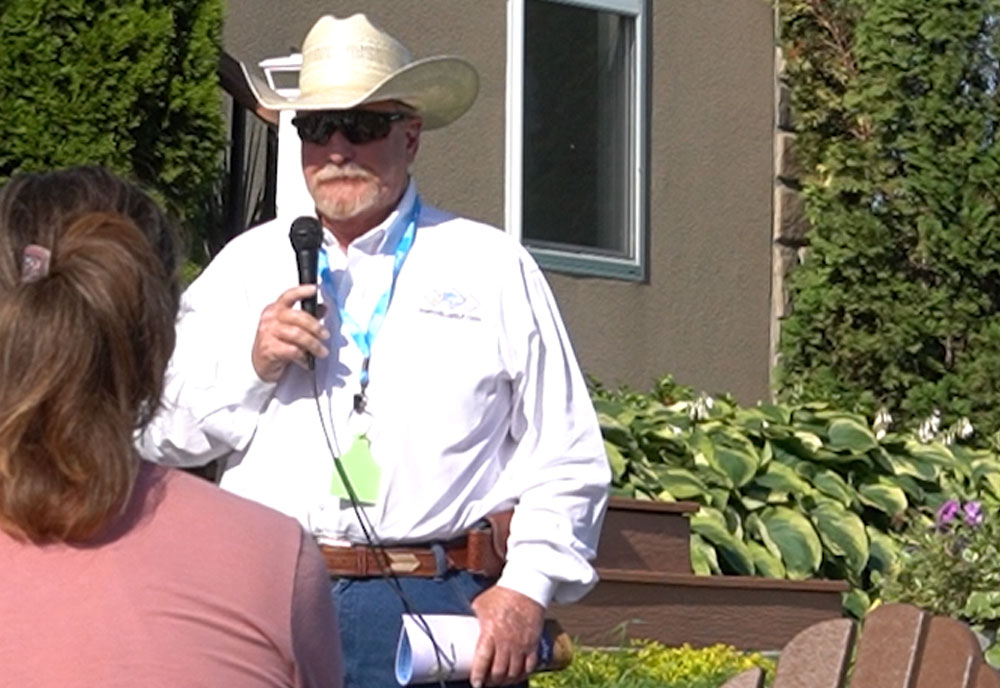Genetic Mastery Meets Collaborative Innovation on the Road
Expert: Larry Gran, Vice President of Genetic Services
A Traveling Showcase of Innovation and Partnership
This year’s annual event wasn’t hosted at a single ranch—instead, it became a moving classroom for agricultural excellence. On June 21st 2025, attendees relocated to several ranches, each offering a unique glimpse into how top-tier genetics, stewardship, and innovation intersect. Among the highlights: a stop at the 808 Ranch, where producers gathered to discuss not just cattle, but collaborative strategy.
As a speaker at this event was Larry Gran, Vice President of Genetic Services for Jorgensen Land & Cattle. Through keynotes, pasture ride–throughs, and deep-dive discussions, Gran helped to shar what’s made Jorgensen a leader in the field—and how those tools are being distributed through Ideal Beef Genetics.
“This isn’t just about what happens at our ranch,” Gran said during one stop. “It’s about what we can build together across operations, across regions, and across generations.”
Beyond Breeding: A Culture of Collaboration
Co-hosted by Molly Manufacturing and sponsored in part by Merck Animal Health, this multi-site gathering was more than a cattle tour—it was a celebration of shared learning. Each brought something different to the table, and the structure of the event allowed producers and vendors to compare, discuss, and collaborate in real time.
“Every ranch we visit brings a different challenge and a different opportunity,” said Gran. “That diversity is what makes events like this so powerful.”
With future events planned to rotate to different states and host ranches, organizers are shaping a tradition rooted in open access, technical transparency, and practical innovation.
Inside the Ideal Beef Genetics Engine
Gran’s sessions covered some of the depth of the Jorgensen genetic program, anchored by the proprietary Ideal Beef Evaluation (IBE) system—a tool that combines:
- 50,000+ genotypes
- 1 million phenotypic data points
- Real-time tracking of performance traits
- Predictive analytics for genetic potential
This isn’t registration for the sake of paperwork—it’s a system designed to forecast results, reduce guesswork, and optimize decision-making across breeding, management, and marketing.
“We’re not breeding toward a perfect look,” Gran noted. “We’re breeding toward profitable, sustainable, long-term function.”
The Motherlode Project and a Tiered Breeding Strategy
One of the most talked-about components of the program was the Motherlode Project—Jorgensen’s embryo transfer initiative focused on their top 10% of cows.
Key Takeaways:
- 2,000–2,500 elite embryos generated annually
- Top 50% of cows receive AI with proprietary semen
- Bottom 50% receive embryo transfers, elevating the entire herd’s trajectory
- All animals are twice-tested through the IV (In Vitro) program
- Registered with the American Angus Association, but evaluated primarily through performance
This dual-track model ensures even lower-tier animals serve as platforms for genetic gain—an approach rooted in practicality and ROI.
Distribution Through Ideal Beef Genetics
Ideal Beef Genetics serves as Jorgensen’s vehicle for making this program accessible across the country. Whether it’s a ranch in the northern Plains or the Southeast, producers gain access to high-accuracy bulls matched to their goals.
“Ideal Beef Genetics is how we take this model and make it scalable,” said Gran. “It gives ranchers the ability to plug into the system—without having to replicate it themselves.”
With bulls leased in 38 states and 20 multiplier herds, the system is designed to deliver real results, whether you’re running 200 cows or 2,000.
Sales, Events, and Shared Momentum
Jorgensen’s commitment to transparency continues through their two marquee sales events:
- April Registered Angus Bull Sale (3rd Monday in April)
- December Mother Lode Sale (focused on elite embryos and donor females)
These aren’t just sales—they’re touchpoints for education, benchmarking, and building community around the genetics movement.
Tech, Data, and Living Genetics
Gran’s presentations also emphasized the technological arsenal behind the program:
- Genomic dashboards and AI-based predictive tools
- Trait and fertility tracking across generations
- Seamless data flow from breeding decisions to pasture performance
“This is a lab, but it’s not a lab in a silo,” Gran explained. “It’s a lab on the land—refining itself with every calf crop.”
The Future: Shared, Measured, Evolving
What resonated most across the tour and its attendees wasn’t just the depth of science—it was the humility and openness of the approach.
“We don’t claim to have all the answers,” Gran said in closing. “But we know how to measure, how to test, and how to improve. And we’re committed to doing it with you, not just for you.”
It’s this blend of expertise, transparency, and collaboration that makes the Ideal Beef Genetics network more than just a supplier—it’s a movement in modern ranching.
